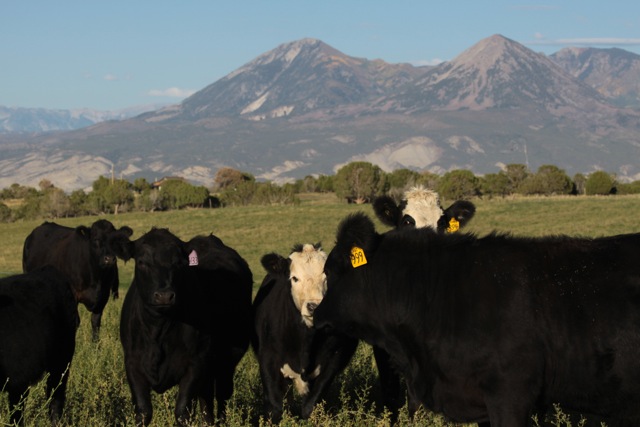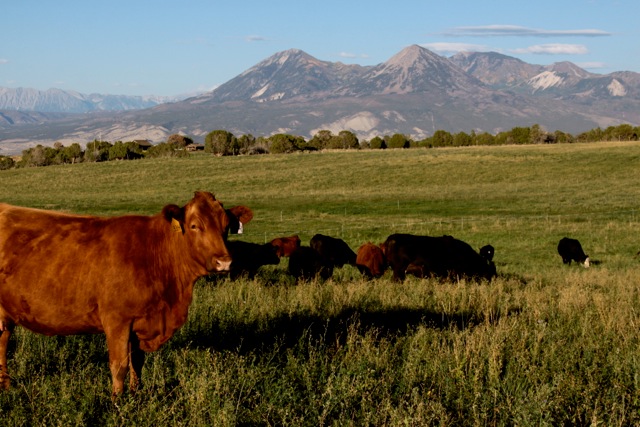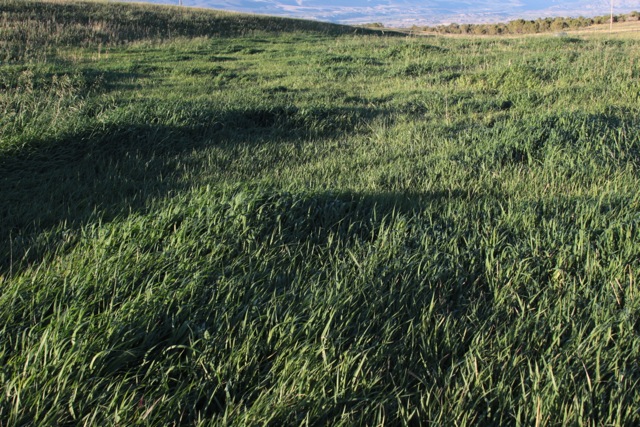Article and Photos by Rita Claggett
“We’re trying to emulate nature long ago, where you had huge herds of bison that would roam around and stay in a tight herd, kept together by predators. They’d plow up the ground with their hoof action, which allows rain to penetrate the earth and soak in more, and drop manure which is fertilizer, and seeds, and then they would move off and go to a new spot, and they wouldn’t come back for quite a while.”
Cynthia Houseweart, founder and proprietor of Princess Beef, explains the concept of Holistic Range Management, which she uses to raise the grass-finished beef that has made her family business a growing success in the North Fork Valley. Houseweart started about 15 years ago with one cow and her calf, and has gradually increased the Princess Beef herd with a careful eye on genetics. This year she sold almost 40 steers to 100 eager customers who had all signed up by June for October delivery.
“Come meet us. Come see what we do,” says Cynthia. “Know exactly what you’re eating. We sell out every year. Next year we’ll give repeat customers first chance at ordering early, then open it up.”
We’re talking at the Houseweart family ranch on Rogers Mesa west of Hotchkiss, which has been in the family for a hundred years. Cynthia’s husband, the talent behind Ira Houseweart Metalworks, plies his art in the shop across the driveway from the farmhouse. Tiny gingerbread houses made by Cynthia and Ira’s two daughters decorate the table, and homemade ornaments hang from the Christmas tree. I passed three cats and two dogs on the way in, and now two more cats visit me at the dining table. Ira’s parents operate Houseweart Veterinary Clinic up the road.
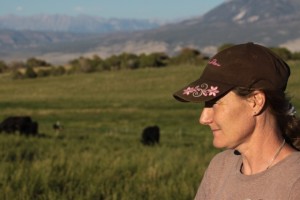
I ask Cynthia to start at the beginning and tell me how she came to be a cattle rancher.
“I graduated from Colorado College,” she says, “and I wasn’t sure what I wanted to do. I had lined up a variety of things for that summer: a grape harvest in Italy, and a wheat harvest in Kansas, and then I wanted to do a cattle drive, and I had a friend who had a ranch out here. So I started my adventures with a cattle drive at the Allen ranch.”
Steve and Rachel Allen were early pioneers of Holistic Range Management in the North Fork Valley, on their ranch at the west end of Fruitland Mesa south of Crawford. Cynthia Butterfield, at the time, did go on to do her other adventures in Kansas and Italy, but, she says, “I came back to the Allen ranch, and never really left after that. That was in ’93.
“I really enjoyed working with Steve and Rachel,” she says, “Being outside, the horses and the cows and the whole works. About two years after I started working for Allens they gave me a cow that I had named Princess. She was always first to the feed wagon so I knew her, and I had gotten to where I could almost touch her. They gave me her and her calf, which I named Duchess. That’s how my herd started.”
About the same time she was starting her herd, she learned of Jo Robinson, an investigative journalist writing about the benefits of raising animals on pasture. “What she was saying worked with how I was feeling. I didn’t want to send the calves that I knew so well off to a feedlot… it didn’t seem like a nice place to send animals.”
Robinson has identified hundreds of peer-reviewed studies from the 1960s to the present that show that raising animals on pasture is good for the animals, the environment, farm families, and the health of consumers. Cynthia based her nascent business on this theory, and started selling the steers to friends and family, keeping the females for the herd. And the rest is, well, history.
In just over 15 years, she has built a herd of a hundred healthy, happy bovines who provide dozens of customers with clean and delicious beef.
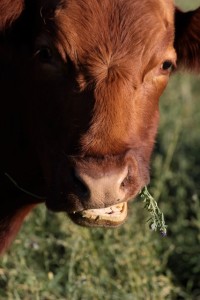 “I think the thing that makes Princess Beef special is that we have our animals from birth all the way to slaughter,” Cynthia explains. By selective breeding, she has grown a herd of smaller cows that are “more efficient” and thrive on grass.
“I think the thing that makes Princess Beef special is that we have our animals from birth all the way to slaughter,” Cynthia explains. By selective breeding, she has grown a herd of smaller cows that are “more efficient” and thrive on grass.
“We could change what we do and buy weanlings and double what we sell as beef, but then we lose the genetics, we lose the history—if they’ve ever been fed antibiotics, if they’ve ever been sick—we know exactly how we treat them.”
While they will use antibiotics if an animal is sick, she explains, they don’t sell it as Princess Beef, it goes to the sale yard. “Every couple of years we’ll have an animal we have to give antibiotics to. What we’ve found is our animals are not sick very often, because they’re not stuck in a corral or feedlot on their own manure. They’re out in the open fresh air and clean pastures, and rotated frequently. We just don’t have those problems.”
That brings us back to the concept of holistic management. “Holistic management is where you form a goal as to how you want to see the future and work towards that. All our decisions we try and go back to that goal. My goal is to make ranching and agriculture sustainable. It isn’t really, right now, especially if you’re playing a commodity market, and the packing houses sort of run the prices on beef.
“It’s a hard thing to do,” she says in a sympathetic tone. “You need a lot of land, especially the way I’m doing it. I’m trying to make a little more money by taking out all the middle people. Is it supporting our family yet? No. We still need Ira’s job, but we’re gaining. It supports itself.”
She continues, “The other thing is how we manage the animals. I try to improve the ground with animal impact. In the long run it’s more sustainable because you’re not doing it with machinery. You’re doing it with animals, that are putting on weight, that you will then make money on. It’s like harvesting free solar energy and making money off of it. You improve the soil, you improve the pasture, you improve the animals, then we eat it, it’s all around a good thing.”
Houseweart uses electric fencing to keep her herd in one section of pasture for a short time, then moves it to another section. Electric fencing also powered by free solar energy, I might add. How long the herd stays on a piece of ground depends on a couple of factors: the time of year, and how the plants are growing. “In the spring when things are growing quickly you want to move them no less than every three days so that they don’t overgraze. You want them to eat the plants before they have a chance to deplete their root reserve, so we make these little paddocks with electric fence and keep the herd pretty tight together and move them frequently. That’s good for a number of things: fly control, so we don’t have to use chemicals to get rid of flies; and they’re always eating a variety of pasture. If the cows are allowed the run of the whole pasture, they will eat the plants they like the best first, and those plants will die out. “If they’re forced to eat everything in a little place and then move on, they call that salad bar beef, they get a variety of things and then move on. They get high quality all the time. They’re not just getting it in the beginning and then being forced to eat stuff they don’t like so much. They eat all the plants at once and then they’re moved, and they get that whole variety of plants again.”
In the past, they’ve run both the mother cows and the beef steers together, but this year with the drought, they were forced to split the herd. Last summer Fruitland Mesa had just one month of water, she says, and she and the Allens had seen the writing on the wall and put out an SOS to the Valley Organic Growers’ Association. As a result, a family on Stewart Mesa offered their pasture for lease, looking to improve their land through animal impact.
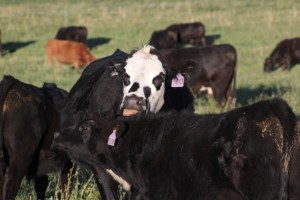 “So we left Fruitland Mesa for the first time and put the mother herd on Stewart Mesa. You have to change every year, according to the weather and pastures and all that. Last year I had my mother herd in Paonia, and my calves I kept at Allens’ until everything burned up, then brought them down here and grazed them on second-cutting alfalfa fields.
“So we left Fruitland Mesa for the first time and put the mother herd on Stewart Mesa. You have to change every year, according to the weather and pastures and all that. Last year I had my mother herd in Paonia, and my calves I kept at Allens’ until everything burned up, then brought them down here and grazed them on second-cutting alfalfa fields.
“ I’ve kept my beef animals together and I’ve given them the best pastures we have,” Cynthia says. The beef calves go to slaughter when they are just over 18 months old. “I want them to put on a lot of weight, where the cows don’t need the super high quality pasture all the time. It’s a little more labor-intensive because I have two herds to move instead of one, but I use the same philosophy, I keep them tightly together and move them frequently.”
The drought also affected the Princess Beef weaning strategy this year.
“We strongly believe it’s better to do across-the-fence weaning, where the calves can still see their moms, and the moms can see their calves, they’ve kept track of them for six months. And they know they’re OK, they just can’t nurse. It’s been so much less stressful and they wean easily, in three days there’s no more mooing.”
This year because of the drought there would have had to be too much moving around so they weren’t able to do that. “Every year you have to make some choices, and monitor and see what works both economically and environmentally, the whole works.”
Houseweart expresses deep concerns for the water resources of the valley. “It’s huge. It’s very scary. We all need to conserve a little more and spread it out a little better. It was very apparent in the drought this year. I mean, if there’s no water there is nothing. It goes back to a desert. So I think we all have to be careful.”
She credits the Allens, whom she characterizes as “very innovative and out-of-the-box thinkers,” not only with getting her started living her dream, but also with saving Princess Beef this year in the drought. Steve sold 500 goats this year, Cynthia says, “and if he hadn’t sold those goats I don’t know what we would have done. If he hadn’t sold them, his goats would have eaten all the pasture that Princess Beef is on now.”
Potential drilling in the valley, she says, is “frightening. Especially from an organic perspective. We are so careful about what we put on our land for our plants and soil health. In looking toward the future, this type of energy development concerns me. Is it going to improve our soil that we depend on? Will our quality of life and land be around for future generations? When we make decisions for our ranching operation, these are questions we seek answers for before we go forward.”
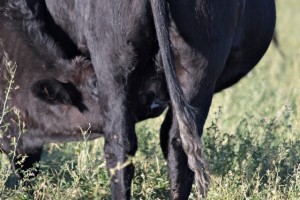
The care and attention paid to every aspect of Princess Beef also shows up in their calving strategy, which both makes life easier for the cows and maximizes return for the business. “We calve a little earlier than what is normal around here. We calve in the spring where grass is starting to turn green and we don’t have to feed them so much hay. As soon as the cows start lactating they need more calories. If you’re calving in winter you’re having to feed a lot of hay, which is the most expensive part of my operation.
“It costs about $400 to $500 to keep a cow and feed her for a whole year,” Cynthia says. “If they’re young and they come in open (i.e., don’t get pregnant) we turn them into ground beef, and it’s fabulous ground beef, we grind all the roasts and the steaks into it; but if it’s an older cow we sell it at the sales yard.”
I ask about the B/B brand I see in Ira’s metalwork on one of the corrals out the window. “I used the Allen brand when I first started Princess Beef, then when I got married we decided we should have our own brand,” she answers. “My great-great-grandfather homesteaded in Holyoke, Colorado, and his original brand was available for me to purchase. Now all of our cows have the original Butterfield 1902 brand on their hips.”
A perfect and poetic touch for this thriving family business. “Our girls are the fifth generation to ranch in the North Fork Valley. They have fun,” Cynthia says. “We keep it happy, they help for a little bit then they’ll go play in the plum trees, then they’ll come back and help again. Right now I feel really good that I can still be with the girls. My family is a bigger priority than the business.
“I like the size of the business right now, it’s manageable with the young girls, and that really is my priority, they’re not going to be young for long. Perhaps in the future … but I want to be able to do it as a family, I don’t want to get so big that we have to hire people.”
Also, she says, “We want to be happy doing what we’re doing. We don’t want it to be so stressful that nobody enjoys what they’re doing. So we want to have fun at what we do.”

